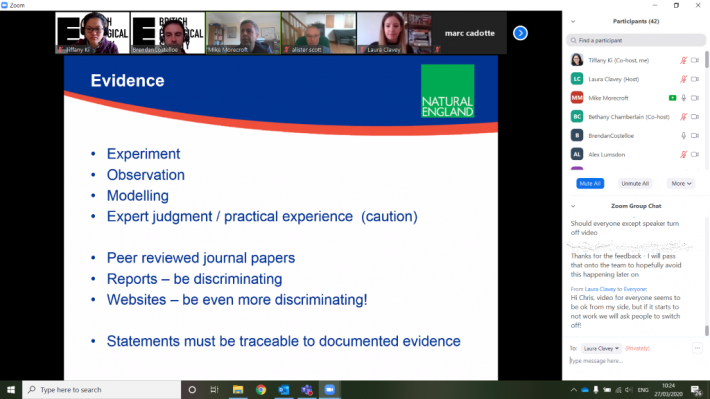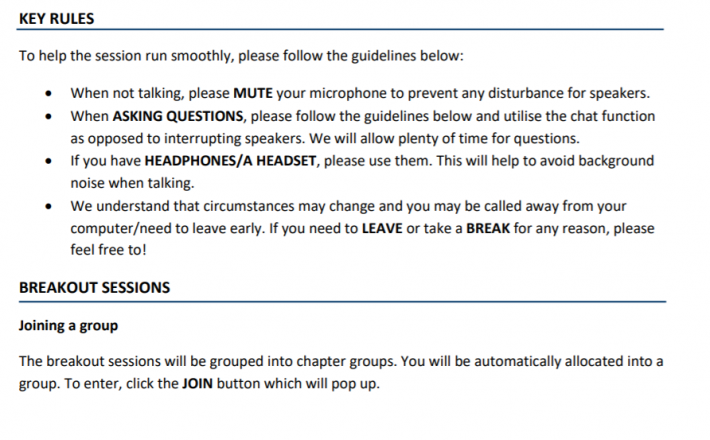Virtual workshops in a locked down world
The BES Policy team ran a successful virtual workshop for their report on nature-based solutions. Here are their top tips from the process.

Using technological solutions for a workshop on nature-based solutions
In mid-January, the BES Policy team set out to provide a report on nature-based solutions (NBS). With over 100 people offering to contribute and ten chapters in the works, the team needed to hold a workshop to debate complex issues of NBS, the scope of the report and how to divide relevant chapters.
Invites were sent out, questions drafted and strategies fleshed out; then, the world changed. At the beginning of March, seeing COVID-19 spreading rapidly, with many events and conferences being cancelled across the world, it dawned upon us that we only had two options for the workshop scheduled at the end of March – cancel it or make it digital. Given that we had so much to discuss – not least the thorny issues of definition and scope – and so many busy people booked in, we decided to go digital!
It now seems surreal that we managed to successfully pull it off – with over 40 contributors online, discussing complex ideas, engaging in debate and sharing drafts and diagrams. Whilst we did have a few technological blips here and there, it demonstrates how much technology has advanced in recent years – with many of us hitherto ignorant to the potential of videoconferencing technology! Having completed the workshop, we wanted to share our tips and lessons learnt with others in the ecology and policy community that may be facing similar challenges.

Bringing people together online for a digital workshop
Top tips for successful digital workshops
Pick the right platform. We used Zoom as it seemed familiar within the scientific community, allowed most participants to be on screen at once (unlike Microsoft Teams which is limited to 4 at a time) and functions such as being able to virtually raise hands or clap provided us with non-verbal cues on how the workshop was going. There were also functions that made the workshop have a professional feel, for example, we displayed the BES logo using the digital background function and used the share screen function to show slides.
However, the right software choice will depend on your individual workshop needs – think about what you want from a workshop and research the options available.

Provide clear guidance and always be on hand to help. We circulated guidance a couple of days prior to the workshop which outlined how the workshop would run and how to participate, and even ran test calls with a few participants to check they were ok with the technology. During the workshop, we were on hand to help with technical difficulties, either via the private chat function, phone or email.
Whilst the workshop was challenging, we found we were able to have a stimulating discussion with the scientific community, including lots of technical detail being covered and attendees having plenty of opportunities to participate.
Use the tech to encourage participation. The chat function allowed people to ask questions without disrupting the speaker. Whilst we asked people to keep themselves muted unless talking, people were able to add comments or ask ad-hoc questions throughout the workshop. Frequent Q&A sessions allowed us to address questions asked in the chat.
The raise your hand function let people to make it known they had something to say, without the need for shouting over each other.
The breakout room feature let us split into smaller groups to facilitate discussion. These groups were small enough to allow for discussion without the need for virtual hand-raising or the chat function.
Practice beforehand. To increase our confidence in the technology, we hosted a ‘mini-workshop’ with BES staff members, during which we tested the functions and our strategy.
Delegate facilitation roles. Roles assigned included speaking, monitoring the chat function, making notes, timekeeping and being available for technology blips. We also had a separate chat for staff members allowing us to easily communicate. Keeping track of all the moving parts, whilst communicating amongst ourselves, turned out to be the most challenging aspect of the workshop.
NB: whilst sharing your screen, it is hard to monitor the chat box or see when people are raising their hands, which limited participation. This can be overcome by assigning a separate person to share the screen, enabling the speaker to monitor questions. A mistake we made was assigning only one staff member to each breakout group which made chairing the discussion and simultaneously making notes difficult.
Making sense of the chat box
After the workshop, we found interpreting the conversation in the chat box to be a major challenge. Whilst you can save the conversation for future reference, it is unstructured and the ability to ask follow-up questions in limited. We found a limitation of Zoom was the inability to reply to a specific message, which would have made it easier to track the conversation.
What next…?
Whilst the workshop was a success, it was just a small part in the process of preparing the nature-based solutions report, and we still have a long way to go. In a wider context, the change in working style and success of online platforms are prompting key questions about how the post-COVID world will look. Will we return to normal or will digital become the new norm? Do the benefits of working digitally, such as reduced costs for office space and reduction in carbon emissions, outweigh the benefits of face-to-face interaction?
Watch this space to find out how we coordinate a 12-chapter report, with over 80 contributors and no face-to-face meetings!
Like what we stand for?
Support our mission and help develop the next generation of ecologists by donating to the British Ecological Society.